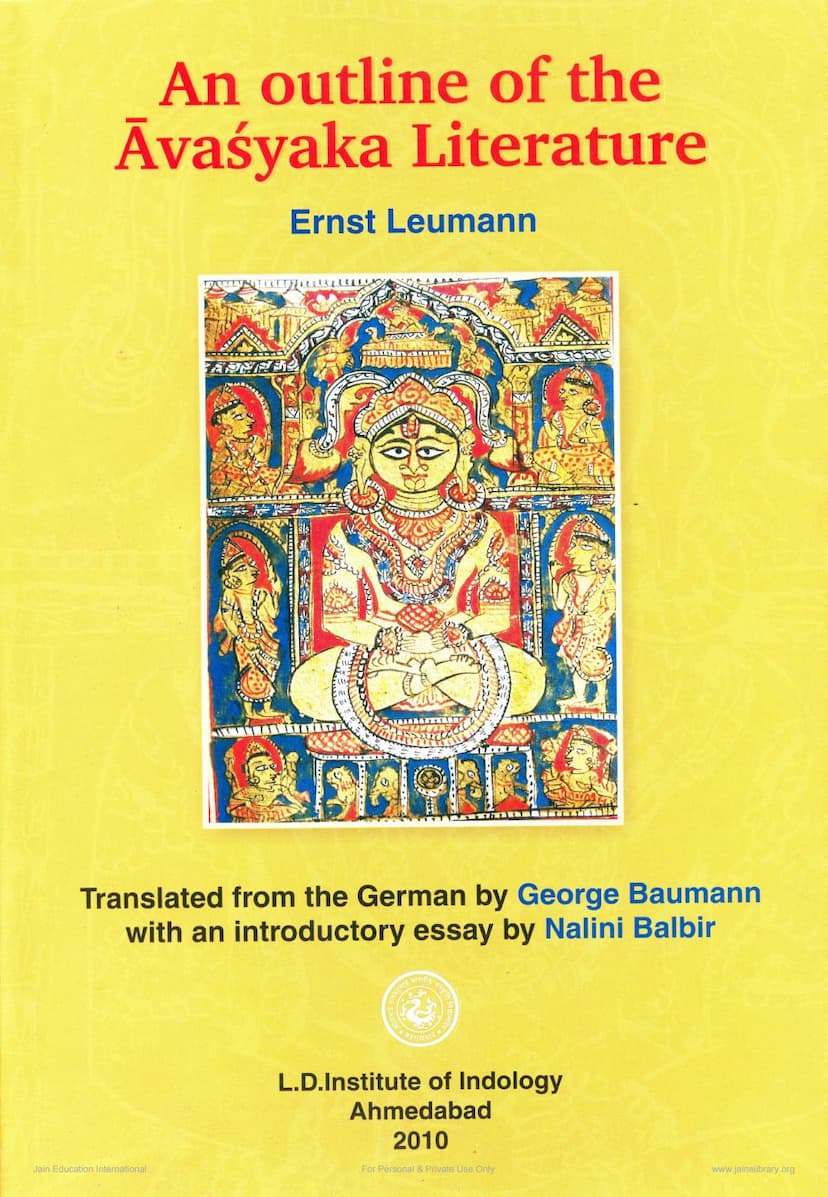Outline Of Avasyaka Literature
Added to library: September 2, 2025

Summary
Here is a comprehensive summary of the Jain text "An Outline of Āvaśyaka Literature" by Ernst Leumann, translated by George Baumann, with an introductory essay by Nalini Balbir:
Overview of the Work:
"An Outline of Āvaśyaka Literature" (original German title: "Übersicht über die Āvaśyaka-Literatur") is a seminal and foundational work by Ernst Leumann (1859-1931), a pioneering scholar in Jain studies. This English translation, made by George Baumann and prefaced by Nalini Balbir, makes Leumann's intricate and insightful research accessible to a wider audience. The book meticulously investigates the entire corpus of Āvaśyaka literature, centering on the Pratikramana and tracing its historical and textual developments. Leumann's work is characterized by its novel, multi-angled approach, creative presentation, and pioneering focus on less central areas of Indology like Jainism and Khotanese studies. Despite its immense importance, Leumann's work is noted for its idiosyncratic presentation, often presupposing prior knowledge, and for being, in some cases, unfinished.
Key Contributions and Insights:
- Coined the Term "Āvaśyaka-Literatur": Leumann's seminal contribution was recognizing the Āvaśyaka not as a single work but as a complex, interconnected body of texts. This insight forms the core of his study.
- Centrality of the Āvaśyaka-niryukti: The book focuses on the Āvaśyaka-niryukti and its commentaries, including the Cūrṇi and tīkā by Haribhadra and Malayagiri.
- Inclusion of Viśeṣāvaśyaka-bhāsya: Jinabhadra's significant work, the Viśeṣāvaśyaka-bhāsya, and its commentaries are thoroughly examined, representing a major contribution to understanding the development of Jain philosophical and textual traditions.
- Intertextual Approach: Leumann demonstrated the necessity of an intertextual approach to understand the core and development of the Āvaśyaka literature, linking it to other canonical works like the Bṛhatkalpabhāṣya and the Anuyogadvārasūtra.
- Śvetāmbara and Digambara Traditions: The study bridges both the Śvetāmbara and Digambara traditions, highlighting Leumann's crucial discovery of the relationship between the Śvetāmbara Āvaśyaka-niryukti and the Digambara Mūlācāra. Leumann emphasized the antiquity and importance of the Digambara tradition, contributing significantly to its study in the West.
- Textual Layers and Stratification: A key methodological contribution is Leumann's focus on determining textual layers and identifying stratification within the complex network of texts, aiming to reconstruct the "original" Niryukti. This involves detailed philological analysis and comparative studies of manuscripts.
- Historical Context and Figures: The work provides detailed explorations into the historical figures central to the Āvaśyaka literature, particularly Bhadrabāhu (demonstrating the existence of two Bhadrabāhus: the historical one and a fictitious literary figure) and Jinabhadra (analyzing his unique style and contributions to cosmology, epistemology, and ethics).
- Analysis of Exegetical Traditions: Leumann meticulously analyzes the exegetical traditions, including the roles of commentators like Śīlānka, Hemacandra, and Malayagiri, and their engagement with earlier texts and differing recensions.
- Metrical Analysis: Leumann's attention to metre as a chronological criterion is highlighted, demonstrating his sophisticated philological method.
- Concept of "Āvaśyaka": The book clarifies the multifaceted concept of āvaśyaka as central to Jaina practice, linking textual units to daily religious rituals for both mendicants and laypeople. The "catechism-like role" of the Āvaśyaka is emphasized.
- Manuscript-Based Research: A significant aspect of Leumann's work, as noted by Baumann, is his reliance solely on manuscripts rather than printed editions. The translation and publication in India are particularly welcomed, given Leumann's lack of personal travel to India but his significant scholarly connections and influence there.
- Comprehensive Appendices and Tools: The translated volume includes valuable introductory essays and tools by Nalini Balbir, such as a note on Leumann's transliteration, a guide to his abbreviations, a list of main Indian manuscripts used, expanding notes, correspondences between Leumann's divisions and modern editions, Prakrit extracts, and English translations of key German reviews of the original work.
Ernst Leumann's Methodology:
Leumann's approach is characterized by:
- Boundless Curiosity and Insight: Driven by a desire for new discoveries and texts.
- Holistic Conception: Seeing the "Āvaśyaka-Literatur" as a unified yet complex entity.
- Philological Rigor: Meticulous analysis of manuscripts, focusing on textual layers, stratification, and the "Urtext."
- Interdisciplinary Approach: Engaging with linguistics, literature, history, and philosophy.
- Attention to Detail: Painstaking work with manuscripts, often creating his own systems of numbering and cross-referencing.
Significance of the English Translation:
The translation by George Baumann, vetted by Nalini Balbir, is crucial for making Leumann's prophetic and seminal work accessible to scholars who do not know German. It opens up Leumann's groundbreaking research to a global audience, allowing for a deeper and wider engagement with the foundational texts of Jainism. The publication in India further reinforces the connection between Leumann's work and the scholarly traditions of Jainism.
In essence, "An Outline of Āvaśyaka Literature" is a scholarly monument that reconstructs the historical, textual, and conceptual development of a central body of Jain literature. Leumann's meticulous research, made accessible through this translation, continues to be an indispensable tool for anyone studying Jainism.